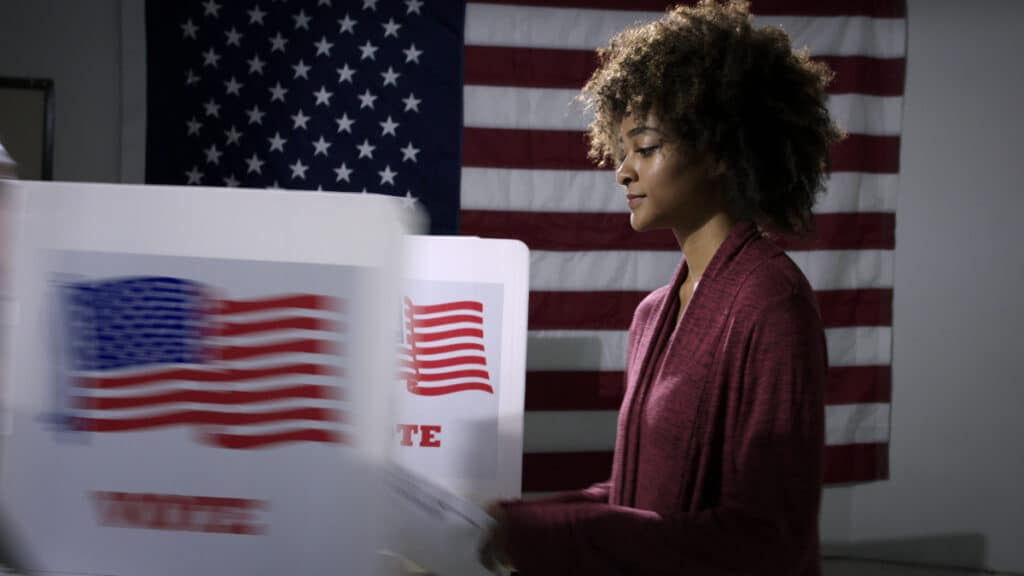Evaluating New Technology for Equitable and Secure Voter Verification
Juan Gilbert, Jasmine McKenzie, Alaina Smith, London Thompson / Apr 7, 2023Dr. Juan E. Gilbert is the Andrew Banks Family Preeminence Endowed Professor and Chair of the Computer & Information Science & Engineering Department at the University of Florida. He leads the Computing for Social Good Lab, where Jasmine McKenzie, Alaina Smith and London Thompson are PhD students.
Elections are the bedrock of democracy. As such, access to voting is essential; however, there have been severe challenges over the decades to voting access for people of color, those with disabilities and other marginalized groups in the United States. One of those challenges revolves around the verification of voter eligibility. New technologies may present solutions to this problem, but substantial research is necessary to verify the efficacy and address the downsides of any new tools and techniques that determine who has access to the franchise.
Essentially, voter verification determines who has access to vote. Voter verification methods vary across the U.S. by state. Each state requires some form of identification to register and vote. These requirements have often served as tools to disenfranchise communities of color.
For example, in Texas, a pistol license granted by the Department of Public Safety is an acceptable form of voter identification (ID); however, a student ID from a Texas public university is not. A driver's license is the primary form of voter identification in most states; however, voters of color and the elderly may use public transportation and may not have a state-issued driver's license. These disparities in state criteria have the effect of disenfranchising specific categories of voters. These criteria have been noted not only as instruments that deny communities of color their rights, but also those who are disabled.
In an effort to eliminate these disparities, we propose investigating an alternate technique for voter verification. The proposed new voter verification technique will use a form of facial recognition to verify voters. This is notably different from using facial recognition for identification, which presents several thorny issues. If implemented carefully, the proposed voter verification system has several advantages, and could therefore help make verification secure and equitable for all voters. But, there are substantial questions that must be addressed thoroughly before such a system could be deployed.
Facial Recognition Technology: Identification vs. Verification
Facial recognition is a type of biometric security that can identify or confirm an individual’s identity using an image of their face. This technology works by determining the similarity between two images– whether they are in real-time, photos, or videos– to identify an individual using biometric markers digitally mapped to an individual’s facial geometry. Facial recognition technology can be used for a variety of purposes, each with their own ethical and technical considerations. Here, it is important to distinguish between its use for identification and for verification.
The use of facial recognition for identification employs artificial intelligence/machine learning to match a human face against a database of faces. Essentially, the technology is used to identify an individual amongst many others, e.g. to find a person in a crowd. While this technology is presently used for many public and commercial purposes, such as in law enforcement, airports, border control, financial services, etc., it has its pitfalls. Several cities have banned facial recognition identification for use by police and local agencies, and state governments such as Illinois have implemented or considered restrictions on its use. While state of the art facial recognition identification algorithms have a high classification accuracy of over 90%, this does not apply universally and does not mean all systems produce this level of accuracy. Recent studies show that there have been divergent error rates across demographic groups, with the poorest accuracy found consistently in Black female subjects around 18-30 years old. Companies, such as IBM and Microsoft, ran studies to apply these algorithms to subjects of different skin tones and found that the algorithms performed the worst on darker-skinned females, with error rates up to 34% higher than for lighter-skinned males.
Advocates also fear that if facial recognition algorithms are widely adopted, the technologies can harm the Black community in line with existing racist law enforcement patterns while potentially damaging other marginalized populations. Black Americans are more likely to be arrested and incarcerated for minor crimes than White Americans. These rates could lead to bias and flaws in the systems to create a feed-forward loop where racist policing strategies lead to disproportionate arrests of Black people and are subject to future surveillance. There are numerous reports of Black Lives Matter protests following the murder of George Floyd where the protestors were monitored and identified using facial recognition identification, threatening rights like privacy, freedom of expression, and freedom of association.
Typically, when facial recognition identification systems are employed, the subject under review does not know the process is happening, does not collaborate, does not directly benefit from the process, and there is zero control of privacy. For example, in Detroit, Michigan, Robert Williams was arrested at his home after a facial recognition identification system identified him as a thief. As the ACLU’s Philip Mayor and attorney Victoria Burton-Harris noted, “[t]here was just one problem: Face recognition technology can’t tell Black people apart.” Mr. Williams spent the night in jail, but was clearly innocent.
In contrast to the use of facial recognition for identification, there is another, distinct use case: verification.
Facial verification technology also uses biometrics to digitally map an individual’s facial geometry. This technology then uses those biometrics to create a facial signature that compares a digitally mapped face to another photo to verify an individual. Facial recognition verification is used to verify an identity claim, e.g. verify “you are who you say you are.” It can be considered as another form of a password, meaning, it belongs to a single individual. Common facial recognition verification uses include for the unlocking of smartphones, banking, and many more situations. Verification can enhance how we operate in business with respect to security and identity fraud prevention, access and authentication, and accessibility to services, benefits that may not apply to the application of facial recognition for identification.
In summary, facial recognition identification is problematic, but it is not the same as facial recognition verification. With that distinction in mind, it is therefore worthwhile to explore whether facial recognition verification can be used to securely and equitably identify voters.
Voter Verification with Facial Recognition Technology
Given biometrics' high accuracy in state of the art systems, facial recognition verification could represent a convenient and safe way for citizens to verify their eligibility to vote. One potential benefit is in addressing concerns over voter fraud, while the other is in addressing concerns over restrictions on voter identification that contributes to the disenfranchisement of marginalized groups.
While voter fraud is rare, there are many different potential vulnerabilities in voting systems, including the fraudulent use of absentee ballots, ineligible voting, impersonation at the polls, duplicate voting, false registrations, and more. Voter ID laws are often put in place to address these vulnerabilities. (It is worth mentioning that between 2000 and 2014, there were only 31 documented instances of voter impersonation.)
A more substantial problem is the proliferation of restrictive voter ID laws. Voter ID laws are in place in 35 states, according to the National Conference of State Legislatures. As previously mentioned, voter ID can be used to disenfranchise various populations, and are seen to disproportionately affect communities of color. One analysis employing aggregate county turnout data from 2012-2016 found that “the gap in turnout between more racially diverse and less racially diverse counties grew more in states enacting new strict photo ID laws than it did elsewhere,” concluding that “strict voter ID laws appear to discriminate.” Another study, published in 2018, found that voter identification laws have a disenfranchising effect on minorities simply because “people of color are less likely to have an ID.”
Facial verification could potentially address this issue. The process would begin when a voter registers to vote. During the voter registration process, a photo of the voter would be acquired and used as the basis for future facial recognition verification. This photo becomes the new voter ID for this voter. As such, when the voter goes to vote, they don’t need to bring any physical ID; rather, their face is their ID. A poll worker would simply take a photo of the voter and the system would compare the new photo to the photo stored in the registration system. The system would then report whether the photos sufficiently match. The poll worker would then make a decision to allow the person to vote. The new photo might also be used to update the facial recognition system’s voter ID for this person each election cycle.
Ethical and technical considerations for further study
While facial verification technology has reached a level of accuracy that makes it reliable in large scale applications, such as to unlock smartphones, its application in the context of voter verification is untested. And, there are engineering and ethical considerations to address around the acquisition, storage, and access to the data required to make such a system work. We propose to conduct a course of research to validate this technology and address these considerations for voter verification.
This study will investigate the utility of using facial verification technology versus photo ID to verify voters. Research questions may include:
1. What state of the art facial verification algorithms and systems are most appropriate for this use case?
2. How might the acquisition of voter photos be incorporated into the voter registration process, and might there be other systems (such as Driver’s license or other state identification photos, such as university or government employment ID systems, that might be tied to such a process?
3. How might photos themselves be hashed or otherwise encrypted to prevent them needing to be stored as images in state databases?
4. What rules and regulations need to be in place to prevent the use of photos acquired for voter verification being used for other purposes, such as by law enforcement, of which knowledge of such use might discourage voters from registering?
5. What legal, regulatory or policy changes would be necessary to implement such systems? For instance, in states or other jurisdictions with rules against the use of facial recognition or other biometrics, could such systems be exempted for the purposes of voter verification, if adequate protections are in place?
6. How would the use of such a system change the workflow of poll workers and election administration officials more generally?
7. What recourse should be available to voters in the event that the system fails, either due to a rare failure to correctly identify an individual or some other fault, such as internet connectivity?
8. What additional security vulnerabilities might such a system create, and how can they be mitigated?
9. What research is necessary to track the efficacy of such a system against alternatives over time?
10. How might public perception of facial recognition technologies affect the suitability of its use for voter verification?
The American Civil Liberties Union (ACLU) identified three key issues when evaluating the Internal Revenue Service (IRS) implementation of ID.me for facial verification. Any implementation of facial verification technology that does not address these questions should be opposed. The questions are as follows:
1. “The lack of accessible offline options”
If done properly, voters will register in person. For example, when a voter goes to register or vote for the first time, the initial photo will be taken at that point in time. Allowing voters to upload a photo, or selfie, is an option, but must be done properly with accessibility, security and privacy in mind. But, there must remain options for voter verification that “preserve offline ways of doing business,” including mechanisms that do not require facial verification.
2. “Outsourcing a core government function”
Again, if voter verification is done properly, this function should not be outsourced. Government IT staff should be competent and appropriately resourced to develop and manage any facial verification system.
3. “Biased biometrics that aren’t subject to independent audits”
Voter verification algorithms and systems should be audited, and we propose they should be tested with various communities/demographics, particularly those most at risk. This technology is working to unlock phones without any issues with respect to skin tone, suggesting it is ready for voter verification. But, proper testing is necessary.
Further, a number of countries are experimenting with or implementing biometrics for voter verification, according to the International Institute for Democratic Electoral Assistance. We should watch these and observe their practices/experiments, as they may produce additional insights. Given the challenging issues surrounding voter verification, facial recognition for voter verification is an option that has the potential to make this process more accessible, secure and equitable in future elections, if carefully implemented.
Authors




